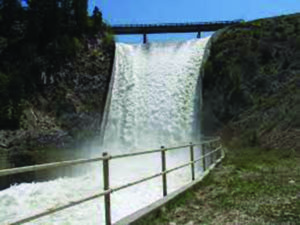
On August 1, 2021, the Montana Department of Natural Resources and Conservation (DNRC) will begin a construction project below Painted Rocks Dam. The purpose of this project is to develop access for future maintenance, repairs, and safety improvements to the lower spillway and outlet area of the dam.
Painted Rocks Dam was constructed between 1938 and 1940 and is classified as a high hazard structure by the Montana Department of Natural Resources and Conservation (DNRC) due to the potential for loss of life in the event of a dam failure. The dam impounds approximately 32,360 acre-feet of water at the maximum normal reservoir elevation of 4,729.5 feet, which corresponds to the spillway crest elevation. Painted Rocks Reservoir provides water storage and supply for irrigation and fisheries. The reservoir also provides regulation of instream flow rates and recreational opportunities for the local area. The primary features associated with Painted Rocks Dam include the embankment dam, spillway, and outlet works.
According to Larry Schock, a DNRC Civil Engineering Specialist and manager of the Painted Rocks Reservoir Dam, a feasibility study is currently underway “because we know that down the road, we are going to have to do some major rehabilitation of the dam to bring it up to current standards. The main problem is that there is no access to the toe of the dam, making some maintenance features very difficult and expensive.”
Planned activities include the construction of a bridge and improvements to the existing primitive road. Approximately one-half mile of the road will be improved to a 16-foot width with gravel surfacing. A single-lane bridge will be constructed immediately downstream of the uppermost boat launch site on the West Fork Bitterroot River.
Construction activities will begin on August 1, 2021 and continue through the winter months. The project is expected to be completed in spring of 2022. Once completed, the public will have vehicular access to the improved road on the east side of the river, and foot access across the new bridge to public lands on the west side of the river.
Effective August 1, 2021, the uppermost boat launch downstream of the dam, along with the primitive road which passes near the USGS gaging station, will be closed to public use. Recreationists will find alternative river access at a developed fishing access site located about 3 miles downstream at Bonnie Blue Bridge, on Mud Creek Road.
The school bus turnaround area on West Fork Road (Hwy 473) will also be closed to general public use, although it will be opened at limited times to allow for the drop-off and pick-up of students.
To help facilitate construction activities, contract water deliveries and stream flows in the West Fork Bitterroot River will be reduced two weeks earlier than normal.

According to Schock, the reductions in dam outflows will begin on September 1, 2021. Flow reductions of approximately 50 cfs will be made every 3-4 days until September 20, 2021. Releases from September 20 through December 31, 2021 will be held at 60 cfs, which is close to winter flows. Additional short-term stream flow reductions to 40 cfs may occur three to four days per week to accommodate construction activity. These reductions will last less than four hours. From January 1 through March 31, 2022, stream flows will be held as low as possible but may reach 90 cfs or higher to manage reservoir levels in advance of spring runoff.
The agency expects river flows and public access to the river will be fully restored following completion of this project prior to the 2022 runoff cycle.
Water flows into the Painted Rocks Reservoir have dropped off early this year. Reservoir inflows to the reservoir dropped 58% in one week last month, falling to 269 cfs on June 23 from 460 cfs the week before. According to Schock, this is three to four weeks ahead of schedule.
“These types of low flows usually aren’t seen until sometime in August,” said Schock.
He said the dam will be operated in a manner to ensure that the outflows match the inflows, and a small amount of water will always be flowing over the spillway. However, the bulk of the water will always be coming out of the low-level outlet.